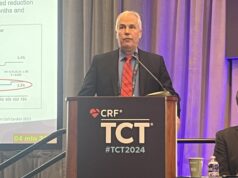 The DynamX (Elixir Medical) bioadaptor system met non-inferiority at one year for target lesion failure (TLF) in a trial comparing the device against the Resolute Onyx (Medtronic) drug-eluting stent (DES) in a broad population of patients undergoing percutaneous coronary intervention (PCI).
The DynamX (Elixir Medical) bioadaptor system met non-inferiority at one year for target lesion failure (TLF) in a trial comparing the device against the Resolute Onyx (Medtronic) drug-eluting stent (DES) in a broad population of patients undergoing percutaneous coronary intervention (PCI).
This is the headline finding from the INFINITY-SWEDEHEART trial, presented by David Erlinge (Lund University, Lund, Sweden) during a Hot Line trial session at the 2024 European Society of Cardiology (ESC) congress (30 August–2 September, London, UK).
As well as the primary non-inferiority endpoint, Erlinge reported that landmark analyses of the trial show that the device offers sustained, statistically significant low event rates across all major clinical endpoints, which he said is demonstrative of an advantage over the DES from six months to one year.
The device is implanted in a similar fashion to a DES but begins “unlocking” after it is encapsulated with tissue and its absorbable polymer coating is resorbed. This is intended to allow the vessel to grow and adapt to maintain established blood flow lumen.
INFINITY- SWEDEHEART set out to evaluate the safety and efficacy of the bioadaptor compared to the DES in a population representative of every day clinical practice, including a large proportion of acute coronary syndrome (ACS) patients, from 20 sites across Sweden.
The trial enrolled 2,400 patients (aged between 18 and 85 years) requiring PCI who had previously untreated chronic coronary syndrome (CCS) or ACS and had achieved a successful target vessel pre-dilation. Patients were randomised in a 1:1 ratio to either bioadaptor (1,201 patients; average age 68 years; 24% female) or DES (1,198 patients; average age 68 years; 24% female).
The primary endpoint was the TLF rate, defined as a composite of cardiovascular death, target vessel myocardial infarction (TV-MI) and ischemia-driven target lesion revascularisation (ID-TLR), at one year.
At one year, Erlinge reported that there was an 18% reduction in the TLF rate of the bioadaptor compared to DES (2.35% vs 2.77%), demonstrating non-inferiority (p<0.001), driven by low rates of TV- MI and ischemia-driven TLR with bioadaptor compared to DES.
The one-year results also demonstrated a 14% reduction in the target vessel failure (TVF) rate (3.03% vs. 3.52%) with the bioadaptor compared to DES.
Further prespecified powered landmark analyses showed a significant reduction and plateau in TLF (0.2% vs. 1.3%, p=0.003) and TVF (0.6% vs. 1.8%, p=0.008) events after six months, when the bioadaptor’s mechanism of action is enabled, driven by a favourable reduction in CV death, TV-MI, and ischemia-driven TLR with the bioadaptor compared to DES.
These latest data build on late-breaking two-year BIOADAPTOR RCT data presented at EuroPCR 2024 (14–17 May, Paris, France), which demonstrated a statistically significant benefit of the bioadaptor over the drug-eluting stent in patients treated for de novo lesions (per protocol patient population analysis).
DynamX was recently granted US Food and Drug Administration (FDA) breakthrough device designation for an indication to improve coronary luminal diameter, restore haemodynamic modulation, and reduce plaque progression in patients with symptomatic ischemic heart disease due to discrete de novo native coronary artery lesions.










